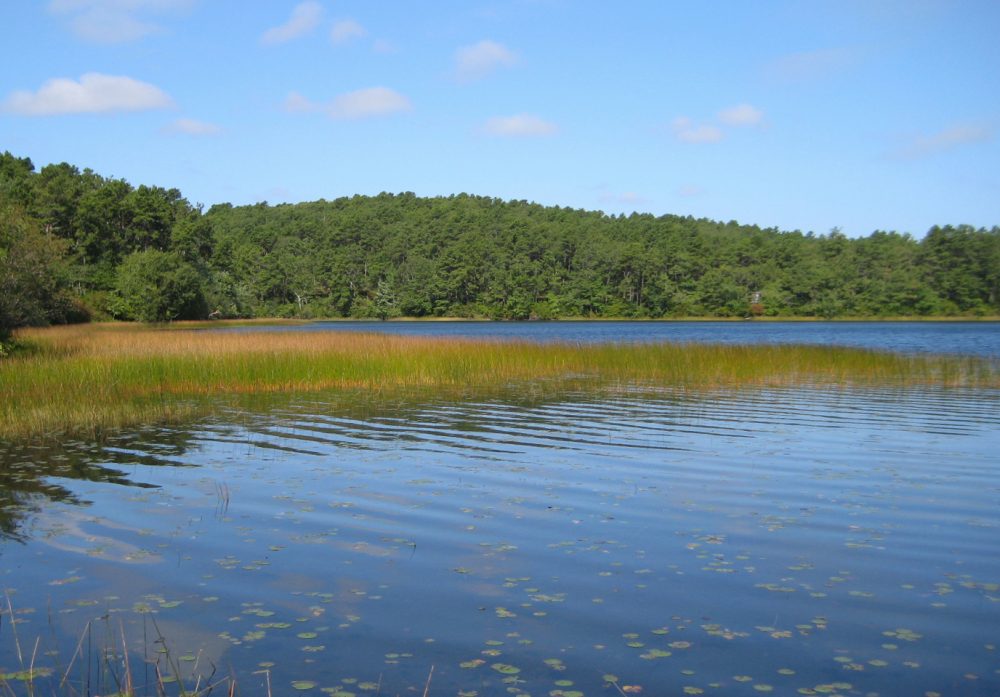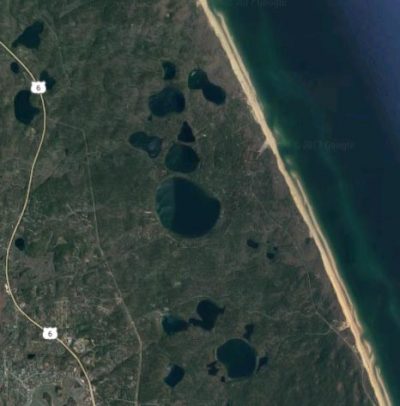Advertisement
CLIMATE CHANGE IN MASS.
Cape Cod's Kettle Ponds Are Showing Signs Of Climate Change

For years, scientists have been warning about the transformation of Cape Cod's seashore due to climate change. Now they're saying the Cape's other waterways, especially its hundreds of kettle ponds, are also affected.
We recently visited Snow Pond, a kettle pond in Truro, with Stephen Smith, a plant ecologist at the Cape Cod National Seashore. He says these kettle ponds may be showing the most visible signs of climate change on Cape Cod.
Deborah Becker: Can you describe a kettle pond and what you're doing to monitor them?

Stephen Smith: They were originally formed by melting blocks of ice that left depressions in the landscape that eventually filled up with fresh water. There's about a thousand of these kettle ponds actually throughout Cape Cod. So these ponds are isolated bodies of water, they're like bowls of soup sitting in the landscape. They're highly influenced by atmospheric conditions, namely precipitation and the general climate or weather conditions.
Two things have significantly affected our kettle ponds over the last couple of decades. One is kind of a good news story: They're recovering from acid rain, so our ponds are becoming less acidic and that's because rain water is becoming less acidic because air pollution regulation has dramatically reduced concentrations of nitrates and sulfates that caused this acidity in the '80s and '90s. The other one is climate change has caused significant warming of these ponds, particularly in the surface layers and also vertically. There has been a dramatic change in the temperature structure from top to bottom.
Advertisement
So what are you seeing in these ponds that you think is attributable to climate change?
Surface water temperatures have increased by almost 3 degrees Celsius in the last 15 to 20 years and that's a huge, huge change. This warm water sits atop cold water and it doesn’t mix with the bottom layers. That's happening longer and longer during the season. That influences a lot in terms of where algae in the water column reside. It affects all kinds of biogeochemical reactions in the bottom waters.
When you talk about the water temperature, how warm is it?
Top of the pond, somewhere around 25, 26 degrees Celsius.
So like mid 70s Fahrenheit at the top, and the bottom would be how cold?
Dive down the deepest pond, 8 degrees Celsius. ... There used to be less difference between surface and bottom water temperatures. That differential has increased significantly in the last few decades.
"There has been a dramatic change in the temperature structure from top to bottom."
Stephen Smith, Cape Cod National Seashore plant ecologist
So what can you do about that?
By having a level of understanding of what's happening and how climate change is influencing these ponds and what aspects it's influencing then we can speculate and make predictions about what may happen in the future with different scenarios of climate change.
In virtually every pond there is a rising trend of groundwater, and we think what we're seeing there is a direct effect of sea level rise on the hydrology of these ponds. It has implications for the kinds of plants that will germinate, how much of the vegetation will grow under those highly flooded conditions, and the species that will grow.
What do you say to people who say, 'What difference does it make if we lose a species?' Will we notice the difference?
I mean some species, if, for example, with this climate warming, if we see a proliferation of cyanobacteria, people will notice because there could be, given the right species of cyanobacteria, pond closures because of the toxin they produce.
We have some state-listed rare plant species that make these kettle ponds a special place in the landscape in the Northeast. And if we lose some of those then they're kind of gone forever from this part of the world.
If you had a main message to policymakers and the public from your research what would it be?
There are some fairly alarming things that we've seen within the Cape Cod National Seashore. Sea level rise really affecting our salt marshes, warming temperatures are affecting our ponds and their thermal structure, and many other things associated with those types of changes. So these national parks were put in place because they're really special, kind of jewels within the country. If these relatively pristine, mostly pretty healthy, robust ecosystems are showing such changes, then in my mind that's kind of worrisome.
Would you say the main theory here is to try to preserve nature, to let nature try to correct what's going on?
I'm not sure at this point that nature is going to be able to correct a lot of things. You know, we are past the point in many systems where we can just let nature take its course. We need to manage if we're going to, you know, adhere to our mission of preserving these ecosystems in their natural state for future generations to enjoy.
This segment aired on August 2, 2017.

